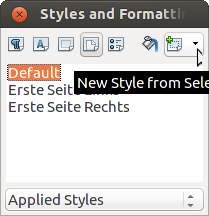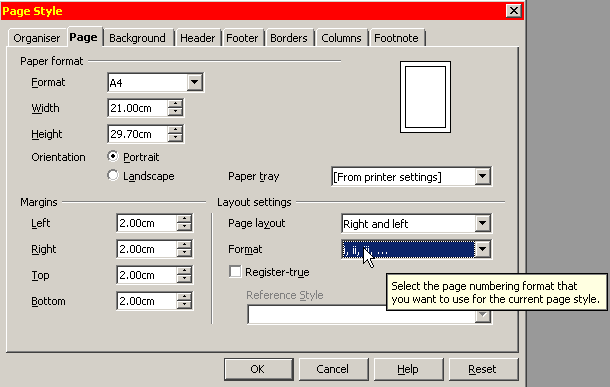Difference between revisions of "Documentation/Writer for Students/Roman Page Numbering"
From Apache OpenOffice Wiki
m |
|||
| Line 6: | Line 6: | ||
|NextPage=Documentation/Writer for Students/Bullets and numbering | |NextPage=Documentation/Writer for Students/Bullets and numbering | ||
}}__NOTOC__ | }}__NOTOC__ | ||
| − | Roman page numbering for | + | Roman page numbering say for an introduction is quite simple: |
| + | * place cursor on any '''Default''' page formatted to your taste (see chapter 13) | ||
* open menu '''Format › Styles and formatting (F11)''' | * open menu '''Format › Styles and formatting (F11)''' | ||
| − | * click | + | * click 4th icon from left to open '''Page styles''' (see illustration 18) |
| − | * | + | * click the black triangle ▼ facing downwards and choose New Style from Selection in order to create a new style based on the presently active one (illustration 22) |
| − | * under the tab '''Organiser''' type Roman and as '''Next style also '''Roman''' so as to allow for | + | <div style="overflow: hidden"> |
| − | + | <!--makes text to start after the picture--> | |
| − | * under the tab '''Page''' | + | [[File:Wfs022_march2015_new_style_from_selection.png|none]] |
| − | + | </div> | |
| + | '''Illustration 22. Black triangle above right to create "New Style from Selection" ''' | ||
| + | * under the tab '''Organiser''' type '''Roman''' and as '''Next style''' also '''Roman''' so as to allow for severalconsecutive pages with Roman numbering (you might prefer to call your new style '''Introduction''' instead) | ||
| + | * under the tab '''Page''' switch the numbering Format from Arabic to Roman (see illustration 23) | ||
<div style="overflow: hidden"> | <div style="overflow: hidden"> | ||
<!--makes text to start after the picture--> | <!--makes text to start after the picture--> | ||
[[File:wfs019-Roman_numbering.png|none]] | [[File:wfs019-Roman_numbering.png|none]] | ||
</div> | </div> | ||
| − | '''Illustration | + | '''Illustration 23. In drop-down menu Format choose format i, ii, iii ...''' |
| − | + | * you needn’t make other modifications such as increasing left margin from '''2cm''' to '''3cm''' or activating a Header since these have already been taken over from the '''Default''' page style (this is precisely the purpose of the option '''New Style from Selection''') | |
* place the cursor at the very end of your last non numbered First page | * place the cursor at the very end of your last non numbered First page | ||
* open menu '''Insert › Manual break › Page break''' and under '''Style''' choose '''Roman'''; in this same menu '''Change page number''' to '''1''' (it will automatically be formatted as i, ii, iii…) | * open menu '''Insert › Manual break › Page break''' and under '''Style''' choose '''Roman'''; in this same menu '''Change page number''' to '''1''' (it will automatically be formatted as i, ii, iii…) | ||
* confirm '''OK''' | * confirm '''OK''' | ||
| − | * later on place cursor | + | * later on place cursor at the very end of your last '''Roman''' style page |
| − | * again open menu '''Insert › Manual break › Page break''' and under '''Style''' choose this time '''Default'''; | + | * again open menu '''Insert › Manual break › Page break''' and under '''Style''' choose this time '''Default'''; and again '''Change page number''' to '''1''' (numbering will automatically appear as '''1, 2, 3'''…) |
| − | * | + | * confirm '''OK''' |
So what have we achieved by this? Your document now contains three page styles: | So what have we achieved by this? Your document now contains three page styles: | ||
Revision as of 17:41, 5 September 2015
- Introduction
- Theory
- Document Structure
- Chapter Headings
- Chapter Numbering
- Table of Contents
- Outline
- Navigator
- Text Body
- Paragraph styles overview
- Reusing styles
- Default Page Formatting
- Title Page
- Papers without a Title Page
- Pages with and without numbering
- Roman Page Numbering
- Group Work
- Proofreading
- Numbered lists and bullets
- Line numbering
- Cross-references
- Footnotes
- Bibliography
- Quotes
- Tables
- Charts
- Pictures
- Snapshots
- Presentations & Graphics
- Cross tables (Statistics)
- Extra Long Web Adresses
- Fonts
- Emphasis
- Special Characters
- Non separable combinations
- Shortcut keys
- Mouse clicks
- PDFs
- Saving your files
- Several files open at once
- Search and replace
- Spell Check
- Synonyms
- Document Infos
- Labels and Form letters
- Help
- Installing Program
- Microsoft Word
- Practice I
- Practice II
Roman page numbering say for an introduction is quite simple:
- place cursor on any Default page formatted to your taste (see chapter 13)
- open menu Format › Styles and formatting (F11)
- click 4th icon from left to open Page styles (see illustration 18)
- click the black triangle ▼ facing downwards and choose New Style from Selection in order to create a new style based on the presently active one (illustration 22)
Illustration 22. Black triangle above right to create "New Style from Selection"
- under the tab Organiser type Roman and as Next style also Roman so as to allow for severalconsecutive pages with Roman numbering (you might prefer to call your new style Introduction instead)
- under the tab Page switch the numbering Format from Arabic to Roman (see illustration 23)
Illustration 23. In drop-down menu Format choose format i, ii, iii ...
- you needn’t make other modifications such as increasing left margin from 2cm to 3cm or activating a Header since these have already been taken over from the Default page style (this is precisely the purpose of the option New Style from Selection)
- place the cursor at the very end of your last non numbered First page
- open menu Insert › Manual break › Page break and under Style choose Roman; in this same menu Change page number to 1 (it will automatically be formatted as i, ii, iii…)
- confirm OK
- later on place cursor at the very end of your last Roman style page
- again open menu Insert › Manual break › Page break and under Style choose this time Default; and again Change page number to 1 (numbering will automatically appear as 1, 2, 3…)
- confirm OK
So what have we achieved by this? Your document now contains three page styles:
- ✔ First page style for the title page
- ✔ Roman page style for preliminary content numbered i, ii, iii…
- ✔ Standard page style for main part number 1, 2, 3…
In between the styles you inserted a manual page break and restarted numbering.
This is basically the same method we already came across in section 10 on group work when you wanted unique headers for each member of the work group and each member therefore needed his or her own individual page style.

